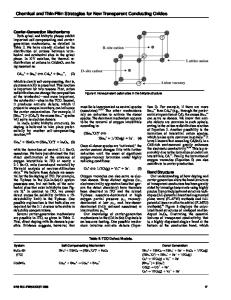Characterization of Transparent Conducting Oxides
- PDF / 277,061 Bytes
- 8 Pages / 612 x 792 pts (letter) Page_size
- 101 Downloads / 381 Views
of Transparent Conducting Oxides Timothy J. Coutts, David L.Young, and Xiaonan Li
Introduction As the areas of the major applications of transparent conducting oxides (TCOs) increase,1 demand will grow for materials having lower sheet resistance while retaining good optical properties. Simply increasing the film thickness is not acceptable because this would increase the optical absorptance. New materials must be developed with lower resistivities than previously achieved and with optical properties superior to those of the present generation of TCOs. This has now been recognized internationally, and novel materials are being investigated in Japan and the United States. In this article, we discuss the properties of the materials cadmium oxide and cadmium stannate. The bandgaps of these are approximately 2.2 eV and 3.1 eV, respectively. Although the former bandgap is too low to be an ideal TCO, it is one of a family of binary oxides, mixtures of which we are presently investigating, both for fundamental purposes and in the hope of developing an improved TCO. The family of TCOs being investigated here and elsewhere is summarized in Figure 1.2 At present, our work at the National Renewable Energy Laboratory (NREL) is primarily concerned with the base plane (CdO, ZnO, SnO2) of this hexahedron. Consequently, we are studying cadmium oxide as well as the other binary oxides. In addition, cadmium oxide is a material that, in solid-state terms, is relatively complicated, whereas cadmium stannate is relatively well behaved. However, it has demonstrated one of the highest mobilities of any semiconducting oxide. Therefore, this pair of materials makes an interesting contrast. In the development of new materials, characterization is inevitably a critical component. In this article, we concentrate on a small selection of methods that we
58
have used to characterize the novel TCOs being developed in our laboratory. We shall first discuss optical methods that are quite familiar but sometimes have not been fully exploited. We shall look carefully at the properties near the fundamental absorption edge in the near-ultraviolet part of the spectrum, and near the plasma edge in the near-infrared. Next, we discuss a much less familiar method of characterizing the electron-transport phenomena that provides a great deal of valuable fundamental information. These topics require a brief discussion of some of the basic theory of the properties of semiconductors. These techniques and others will be used in the development of future TCOs, some possibilities for which we will discuss later. This article is intended to stress the value of careful characterization in determining the fundamental properties of TCOs. The techniques we discuss are general and not specific to the two materials
Figure 1. Phase space of binary oxides being investigated individually and in compounds and alloys as novel and improved transparent conducting oxides (TCOs).
we have selected here. This article is not intended as a review of TCOs. Excellent reviews of the s
Data Loading...











